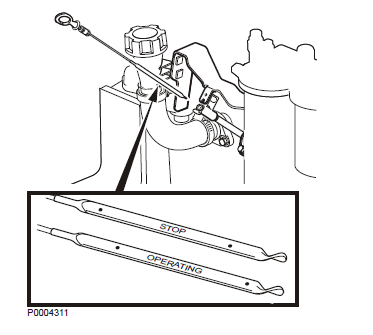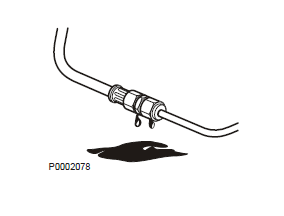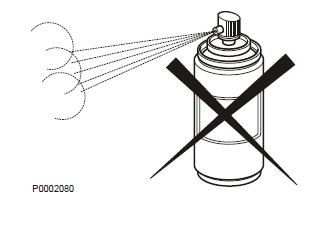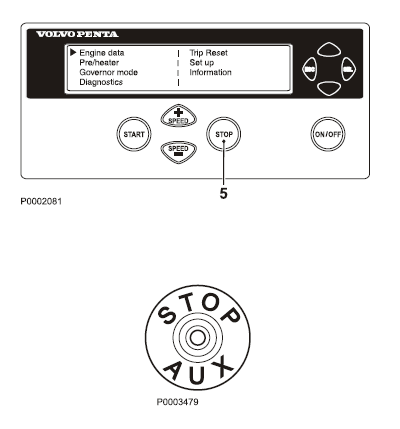Starting
Make it a habit of giving the engine and engine room a visual check before starting. This will help you to discover quickly if anything abnormal has happened, or is about to happen. Also check that instruments and warning displays show normal values after you have started the engine.

WARNING!
Never use start spray or similar agents to start an engine. This may cause an explosion in the inlet manifold. Danger of personal injury.

Before Starting
• Check that the oil level is between the MIN and MAX marks.
NOTICE! The oil level can be read both when the engine is stopped (the STOP side of the dipstick) and with the engine running (the OPERATING side of the dipstick).
For filling refer to Oil level, checking and topping up.
• Open the fuel valves.
• Check the fuel pre-filter; refer to Draining condensate, fuel system page 54.
• Check the coolant level and that the radiator is not blocked externally. Refer to Coolant Level, Checking and Topping Up page 58 and Charge Air Cooler, External Cleaning page 59
WARNING!
Do not open the coolant filler cap when the engine is hot, except in emergencies, this could cause serious personal injury. Steam or hot fluid could spray out.
• Check that no leakage of oil, fuel or coolant is present.
• Turn the main switch(es) on.
• Move the engine speed control to idle, and open the disengageable clutch/gearbox if installed.
IMPORTANT!
Never break the circuit with the main switch while the Volvo engine is running, as this may damage the alternator.
Starting the Engine
The pre-heating time is adjusted to suit the engine temperature, and can last for up to 50 seconds both before and after starting. The starter motor connection time is maximized to 20 seconds. After that, the starter motor circuit is temporarily cut to protect the starter motor against overheating.
Starting in Extreme Cold
Certain preparations must be made to enable engine starting in extreme cold, and in some cases to make starting possible at all:
• Use a winter grade fuel (of a well-known make) that is approved for the prevailing temperature. This reduces the risk of paraffin wax precipitation in the fuel system. At extremely low temperatures, we recommend the use of a fuel heater.
• Use a synthetic engine oil of a viscosity recommended for the prevailing temperature to achieve satisfactory lubrication. Refer to Viscosity page 70. Synthetic lubricants are able to handle a wider temperature range than mineralbased lubricants.
• Pre-heat the coolant with a separately-installed electric engine heater. In extreme cases, a dieselfired engine heater may be necessary. Ask your Volvo Penta dealer for advice.
• Make sure the cooling system is filled with a glycol mixture. Refer to Maintenance page 56.
• The batteries must be in good condition. Cold weather reduces battery capacity. Increased battery capacity may be necessary.
Never Use Start Spray
WARNING!
Never use start spray or similar agents to start an engine. This may cause an explosion in the inlet manifold. Danger of personal injury.

Starting Using Auxiliary Batteries
WARNING!
Explosion hazard. Batteries contain and give off an explosive gas which is highly flammable and explosive. A short circuit, open flame or spark could cause a violent explosion. Ventilate well. 1 Check that the auxiliary batteries are connected (series or parallel) so that the rated voltage corresponds to the engine system voltage.
2 First connect the red (+) jumper cable to the auxiliary battery, then to the flat battery. Then connect the black (-) jumper cable to the auxiliary battery and to a location that is somewhere away from the discharged battery, e.g. the main switch negative terminal or the negative terminal on the starter motor. 3 Start the engine.
WARNING!
Do not touch the connections during the start attempt: Risk of arcing. Do not bend over any of the batteries either. 4 Remove the cables in the reverse order.
IMPORTANT!
The ordinary cables to the standard batteries must not be loosened under any circumstances.
Operation
Correct operating technique is very important for both fuel economy and engine life. Always let the engine warm up to normal operating temperature before operating at full power. Avoid sudden throttle openings and operation at high engine rpm.
Reading the Instruments
Check all instruments directly after starting, and then regularly during operation.
NOTICE! On engines in continuous operation, the lubrication oil level must be checked at least every 24 hours. Refer to Oil level, checking and topping up.
Alarms
If the EMS receives abnormal signals from the engine, the control unit generates fault codes and alarms, in the form of lamps and audible warnings. This is done by means of CAN signals to the instrument. More information about fault codes and fault tracing can be found in the chapter. Fault Handling.
Maneuvering
Operation at low load
Avoid long-term operation at idle or at low load, since this can lead to increased oil consumption and eventually to oil leakage from the exhaust manifold, since oil will seep past the turbocharger seals and accompany the induction air into the inlet manifold at low turbo pressure. One consequence of this is carbon build-up on valves, piston crowns, exhaust ports and the exhaust turbine. At low loads, the combustion temperature may become so low that complete combustion cannot be ensured, resulting in possible fuel dilution of lubricating oil and eventually leakage from the exhaust manifold.
If the following points are done as a complement to normal maintenance, there will be no risk of malfunctions caused by operation at low load.
• Reduce operation at low load to a minimum. If the engine is regularly test-run without load once a week, the duration of this operation should be limited to 5 minutes.
• Run the engine at full load for about 4 hours once a year. In this way carbon deposits in the engine and exhaust system are given the chance to burn up.
Engine Shutdown
During longer breaks in operation, the engine must be warmed up at least once every two weeks. This prevents corrosion in the engine. If you expect the engine to remain unused for two months or more, it must be preserved:
Refer to the chapter Storage page 65.
Before Engine Shutdown
Let the engine run for a few minutes without any load before stopping it. This allows engine temperature equalization and prevents boiling once stopped and also allows the turbochargers to cool down. This contributes to long, fault-free service life.
Stop the Engine
• Disengage the clutch (if possible).
• Depress the STOP-button (5).
Extra Stop
For location of the extra stop, please refer to Maintenance page 47.

WARNING!
Working with or approaching a running engine is a safety risk. Watch out for rotating components and hot surfaces.
After Engine Shutdown
1 Check the engine and engine compartment for leaks.
2 Turn off the main switches before any long stoppage.
3 Carry out maintenance in accordance with the schedule.
For longer breaks in operation
During longer breaks in operation, the engine must be warmed up at least once every two weeks. This prevents corrosion in the engine. If you expect the engine to be unused for two months or more, it must be conserved. Refer to the chapter Storage page 65 .
IMPORTANT!
If there is a risk of freezing, the coolant in the cooling system must have adequate antifreeze protection. Refer to the chapter Maintenance page 56. A poorly-charged battery can freeze and burst; refer to Battery, Charging page 64.
For More Volvo Engine workshop information, please visit:
Volvo Engine Display Control Unit and Display Unit
Volvo Engine Instruments and Controls
Copyright © Guangxi Dingbo Power Equipment Manufacturing Co., Ltd. All Rights Reserved | Sitemap
Update cookies preferencesseokeywords:
test2